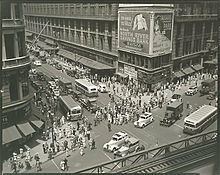 | ||
The IRT Sixth Avenue Line, often called the Sixth Avenue Elevated or Sixth Avenue El, was the second elevated railway in Manhattan in New York City, following the Ninth Avenue Elevated.
Contents
The line ran south of Central Park, mainly along Sixth Avenue. Beyond the park, trains continued north on the Ninth Avenue Line.
History
The elevated line was constructed during the 1870s by the Gilbert Elevated Railway, subsequently reorganized as the Metropolitan Elevated Railway. By June 1878, its route ran north from the corner of Rector Street and Trinity Place up Trinity Place / Church Street, then west for a block at Murray Street, then north again on West Broadway, west again across West 3rd Street to the foot of Sixth Avenue, and then north to 59th Street. The following year, ownership passed to the Manhattan Railway Company, which also controlled the other elevated railways in Manhattan. In 1881, the line was connected to the largely rebuilt Ninth Avenue Elevated; it was joined in the south at Morris Street, and in the north by a connecting link running across 53rd Street.
Due to its central location in Manhattan and the inversion of the usual relationship between street noise and height, the Sixth Avenue El attracted artists; in addition to being the subject of several paintings by John French Sloan, it was also painted by Francis Criss and others.
As of 1934, the following services were being operated:
- 6th Avenue Local - South Ferry to 155th Street all hours, extended to Burnside Avenue via Jerome Avenue Line weekday and Saturday evenings.
- 6th Avenue Express - Rector Street to Burnside Avenue via Jerome Avenue Line - weekday and Saturday peak hours. Trains ran express on Ninth Avenue southbound in the morning and northbound in the evening, and made all stops in the reverse direction.
As with all elevated railways, the Sixth Avenue El made life difficult for those nearby. It was noisy, it made buildings shake, and in early years it bombarded pedestrians underneath with dropping ash, oil, and cinders. Eventually, a coalition of commercial establishments and building owners along Sixth Avenue campaigned to have the El removed, on the grounds that it was depressing business and property values. The city of New York acquired the line from the bondholders of the Manhattan Railway Company for $12,500,000 (of which the city recovered $9,010,656 in back taxes and interest) in 1938, and the El was closed on December 4, 1938 and razed during 1939, paving the way for the replacement underground IND Sixth Avenue Line, which opened between 1936 and 1940.
The footings for the El were rediscovered in the early 1990s during a Sixth Avenue renovation project.
Allegations demolition scrap was sold to Japan
When the El was taken down, concern was expressed that scrap metal from the demolition would reach the Japanese. It was widely believed during World War II that some of this metal was being used in armaments against Americans. That notion became the ironic suggestion within the lines of E. E. Cummings's 1944 poem "plato told."
Twenty thousand tons of scrap metal from the El was sold to a dealer on the west coast who was in the export business. The New York Times pointed out in December 1938 that even if the scrap did not go directly to Japan, for possible use against China, such a large amount of scrap metal arriving on the market would free up metal to be sent to Japan.
At a meeting of the New York City Board of Estimate in 1942, Stanley M. Isaacs, the Manhattan Borough President, denied that steel from the El was sold to Japan. Isaacs said that when the demolition contract was drafted in 1938, "at my insistence the contract provided that not one ounce of that steel could be exported to Japan or to any one else." Isaacs said that the contractor was prohibited from exporting the steel from the El, and carried out his obligation to the letter.
Reports of the supposed sale of the scrap to Japan persisted. In 1961, an attorney for the Harris Structural Steel Company, which was involved in the demolition, told syndicated columnist George Sokolsky that continued reports of the sale of steel from the El to Japan were not accurate. The attorney said that none of the steel from the El reached Japan directly or indirectly.
